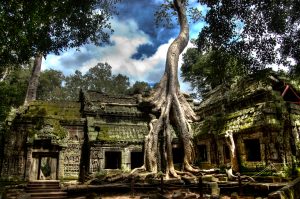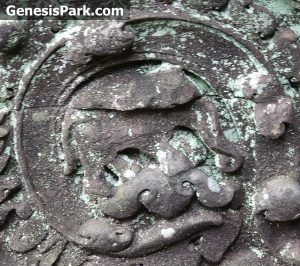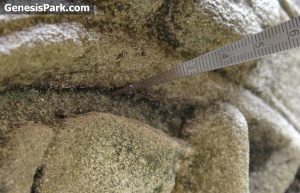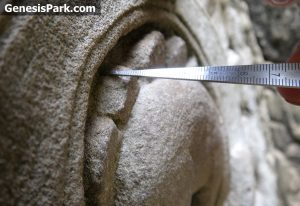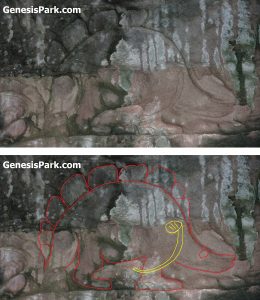The Stegosaur Engravings at Ta Prohm
(Woetzel, D., Answers Research Journal 10 (2017): 213–220.)
Abstract
Bas-relief artwork at Cambodia’s Angkor Wat temple, Ta Prohm, appears to depict a dinosaur (Fig. 1). Though the engraving is readily recognizable as “stegosaur-like,” this dinosaurian interpretation of the engraving has been criticized because of the unrealistically large head and the absence of tail spikes. Moreover, it has been suggested that the “plates” are merely decorative flourishes or background foliage. I personally examined the Ta Prohm artwork, took depth measurements and compared the dinosaurian depiction to the many other temple engravings. I came away satisfied that the objections can be adequately answered. Moreover, I believe there is a second stegosaurus carving in the portico of the temple. My hypothesis is that the ancient artists were seeking to model domesticated stegosaurids, dinosaurs that were still living and known at the time of the temple construction.
Background
There are ruins of over 100 temples in the 400km2 Angkor Archaeological Park of western Cambodia. The most popular of these are the main Angkor temple (Fig. 2), Ta Prohm (Fig. 3), and the Bayon Temple. Not only is this site the world’s largest religious monument, but Angkor Wat was the most extensive urban complex in the pre-industrial world. Built between AD802 and 1431, it was the center of the mighty Khmer kingdom which ruled from the Chinese border over to the Indian subcontinent. Today, this sprawling temple complex in western Cambodia is an internationally famous World Heritage Site. With the fall of the Khmer empire during the 15th century, the temples were abandoned to the jungle until Angkor became the focus of historical research and restoration efforts in the last two centuries.
The Ta Prohm temple was constructed around A.D. 1200 to be a Buddhist monastery and university and it is large enough for thousands of people to have actively worked there. Ta Prohm’s traditional Khmer construction is made up of a series of gradually smaller enclosures. The outer one measures approximately 1 X .65 km. The inner structures contain columns and walls extensively engraved with humans, gods, animals and geometric figures. Larger scenes of Buddhist mythology were also incorporated. Among the site’s many animal depictions is a readily recognizable stegosaur-like carving on one column. Secular archaeologists have recognized the dinosaurian likeness (Freeman and Jacques 2009) and the stegosaur engraving has become a bit of an icon in creationist circles where it is used as evidence that men and dinosaurs coexisted (Cole 2007, Morris 2008, Isaacs 2010, Butt and Lyons 2008).
The patina and context seem to attest to it being original (Patton 2001). Indeed, it would be extremely difficult to deface the artwork on these massive, ancient rocks and not have it be apparent. French photographer Martin Dieulefils made the arduous trek through the jungle to Ta Prohm in 1908. His photos reveal the huge stone blocks obscured by vines and trees. A black and white picture in his book even shows the wall & doorway of the dinosaurian carving site (Figure 4) before it was cleaned (Dieulefils 1909). Figure 5 shows the doorway as it appears today.
Objections to a Dinosaurian Interpretation
Skeptics have pointed to some issues with the alleged stegosaur carving itself. In a recent article, creationist Joshua Cedar noted that the head of the stegosaur “…is considerably larger than that of all sufficiently-represented fossil stegosaurs” (Cedar 2017). Creationist Don Patton dismisses this claim by suggesting the artists were drawing from memory or perhaps from eye witness reports (Patton 2001). Thus, it would not be surprising if the proportions were not exact. This may well be true. Ancient dragon depictions were made by artists within the context of stratified civilizations and they were not likely themselves to observe the large reptiles. Their modeling typically relied on the reports of hunters or travelers who may have seen a live dragon or a carcass in their journey. Moreover, even evolutionary paleontologists have drawn the stegosaurus with a larger head than the skull would dictate, adding cartilage and loose skin (Figure 6). However, I believe there is a better explanation for the blunt, oversized head in the Ta Prohm carving.
The plates along the back are probably the definitive characteristic of stegosaurs as we know them from the fossil record. But the prominent spikes at the tip of the tail are also a diagnostic characteristic. Cedar astutely notes that “some genera (such as Huayangosaurus and Tuojiangosaurus) actually possess more spikes than plates, why does this ‘stegosaur’ carving lack these characteristic features of stegosaurs?” This is a key point since it would be difficult for an observer not to recall this unique offensive weapon. But perhaps this detail was too small for the artist to bother with. In June of 2017 I traveled to the town of Siam Reap and visited Ta Prohm. I observed multiple elephant depictions (Figure 7) around the temple and noted that none of them displayed tusks. (Though, unlike African elephants, the female Asian elephants often lack prominent tusks.)
Some creationists, in defending the dinosaur interpretation, have postulated that there may have been a species of stegosaur that did not have tail spikes. Jonathan O’Brien and Shaun Doyle state, “Possibly it is a type of stegosaurid that has not yet been discovered by paleontologists in the fossil record.” (O’Brien and Doyle 2013). This is certainly plausible. Moreover, a loss-of-function mutation occurring in the roughly three millennia between the time that the Flood preserved the ancient stegosaur remains and the construction timeframe of the temples at Angkor is also quite possible. It might even be that the spiked tail is a sexual dimorphism. But I would suggest that there is a further explanation of the missing tail spikes, as discussed below.
Finally, it has been suggested that the plates that appear to run along the back are not really part of the creature but are merely background vegetation or decorative flourishes (Switek 2009). Certainly, if the plates are removed (Figure 8), most of the resemblance to a stegosaur is lost (thought the beast’s upright posture and huge tail certainly make it look dinosaurian). Therefore, analysis of the plates is very important to the stegosaur interpretation.
Analysis of the Stegosaur-like Engraving
After taking hundreds of photos around Ta Prohm and scouring the entire site, I was struck with some general consistency to the artwork at this temple. The leaf motif around the various images is ubiquitous. But the leaves are almost always around the outside of the image frame (typically a circle, though there are certainly some square frames and numerous larger scenes). In those cases where I could find them inside the frame, they were flat and exhibited shallow relief.
Interestingly, two of the better examples of leaf work inside the frame appear in the same column as the dinosaurian engraving (above and below it). Depth analysis of multiple carvings around this temple consistently revealed relief of approximately 1 mm above the background for decorative flourishes. Note the context animals on the same pillar as the dinosaurian frame. Other than the knobs that stick up at the feet of the stegosaur and water buffalo and on the left and right of the creature below the stegosaur (which appears to be a horse), the background leaf work is quite flat and consistently low relief (Figures 9-11).
However, the plates of the stegosaur carving are distinctly different. It seems that the artist went out of his way to give the plates deep and varied relief, so much so that the tops actually appear stubby rather than pointed when viewed from above. This top down view clearly shows the difference between the plates of the stegosaur and the leaf work around the water buffalo (Figure 12). By using relief around 2.5 mm above the background plane, it appears that the artist clearly meant to portray that these plates are part of the animal. The plates are the same relative relief as the body of the animal (not quite 3 mm) or just slightly lower (Figure 13).
Domesticated Dinosaurs
If the artist was able to model the plated body of a stegosaur so effectively, what about the oversized, blunt head and missing tail spikes? I think a clue to answering that question is the odd triangular shape coming up the side of the animal’s head with a bump or ring at the base of it. Is this merely a poor attempt to portray an ear? Probably not. It follows that the jawline and is unlike the ear of an elephant, hippo, boar, or rhino (all creatures that skeptics have presented as alternative identifications). Moreover, many upright mammalian ears are typically composed of sturdy cartilage that would stand up straight and not curve in, hanging against the upper body. Postulating that these are horns is even more problematic since they would be nearly useless on the sides of the head and curved tight to the body. I postulate that this engraving is a depiction of a captive stegosaur that has been muzzled, much as we would muzzle a dog today (Figure 14). Fitting such a muzzle over a plated stegosaur head and attaching it firmly to the back of the neck would require a large design. This explains both the oversized head and that odd device coming up the side. The large muzzle could double as a kind of bridle, an attachment place for reins. Other engraving at Ta Prohm show bridled horses and riders.
Muzzling would have kept a dinosaur from biting, but the most dangerous part of the stegosaur was the powerful tail, tipped with large spikes. These could easily kill someone if the dinosaur delivered a blow, or even if it inadvertently swiped a bystander. One would presume that these spikes would be removed on captive dinosaurs, the same way that we might defang a captive snake or declaw a pet tiger. Even today, Cambodian elephant tusks are removed from animals being used in public. Would the Cambodians themselves have utilized captive dinosaurs? Not necessarily, but the artist may have heard reports from a nearby culture that had a long history of domesticating dragons.
The Chinese Connection
It is well known that the Chinese have historical records of men interacting with dragons. The book Zuozhuan tells the narrative of how the “ancients raised dragons and how the state used the services of two clans known as the Dragon Rearers and the Dragon Tamers” (Sterckx 2012). As early as 1611 BC the Emperor of China appointed the post of Royal Dragon Feeder, an official whose primary responsibility was to deliver food into the sacred dragon ponds. Historical records tell of a Song Dynasty (960-1279AD) Emperor who raised dragons within his palace compound (Niermann 1994). The Song overlapped the construction timeframe of Angkor Wat. The Italian merchant and traveler Marco Polo visited China in the late 13th century and brought back credible dragon reports (Polo 1961, Niermann 1994). Ming Dynasty Chinese landscape painter Wu Bin (1573-1620) served for a time as the Emperor’s secretary. Among his paintings is a piece entitled “Eighteen arhats” (Figure 15), an ink and color handscroll showing Chinese dragons pulling carts. But the mythical quality to Wu Bin’s work suggests that dragons had become extinct by his time (hundreds of years after the Ta Prohm construction).
“Huang Di, the mythic Yellow Emperor, was said to make sacrifices at the summit of Tai Shan, after driving there in a chariot harnessed to six dragons” (Roberts 2004). In his book on dinosaurs, Paul Taylor references the ancient Chinese Classics when he described dragons pulling the Emperor’s chariot (Taylor 1989). Perhaps the stegosaur was one of the dragons used for this purpose. If so, one would expect that there would be a harness of some kind to attach the dragons to the cart (as Wu Bin illustrated) and a muzzle and bridle for their heads. Moreover, the spikes would almost certainly need to be removed so that they did not destroy the chariot!
It is a matter of historical record that the Chinese sent numerous delegations to visit the Angkor Kingdom. One envoy at the time of the Chinese Emperor Timur Khan, Zhou Dauan, is particularly noteworthy. He came to Cambodia as part of a mission of Chinese nobles in 1296-1297 and stayed there to chronicle life in the Khmer capital. His records are the only written report of the Angkor Kingdom. As a Buddhist, Dauan took some interest in writing about the temples at Angkor (Daguan 2007). It would be expected that with this level of interaction (and religious synergy) some dragon stories and perhaps even drawings would have been brought to Angkor from China.
Second Stegosaur Carving
While scouring the obscure corners of the Ta Prohm temple, I discovered what appears to be a second stegosaur carving (Figure 16) just inside the left portico. Unlike the framed stegosaur on the column, this engraving is part of a larger scene that has mostly disintegrated. The engraving gives some additional insight into the shape of the dinosaur’s head. This second carving shows the more typical, slender head of a stegosaur. Could this perhaps be the same stegosaur at rest in its natural, unmuzzled condition?
Again, there is an odd device etched alongside the neck that arrests our attention. In this case, it is shaped like a rope or narrow strap that hangs down and disappears under the animal. I suspect it is a tether for this captive stegosaur when it was not prepped for public service. Thus, it would seem that this second depiction strengthens the domesticated dinosaur interpretation. Since the tail falls behind another engraved object, this depiction sheds no further light on the issue of the spikes. All we can conclude is that the artist did not deem it important to display the termination of the tail.
Ancient Paleontologists?
The anti-creationist Glen Kuban makes the case for the stegosaur carving being based on fossil finds.
It’s possible that the carving was based on a fossil stegosaur. Stegosaurids are known [sic] several areas of the world, including North America, Europe, Africa and East Asia. Although fossil finds are not frequent or plentiful in heavily vegetated areas like Cambodia, several stegosaur genera have been reported from the Jurassic of China (which once shared its southern boarder [sic] with the Khmer Empire). These include Huayangosaurus, Tuojiangosaurus, Chungkingosaurus, Chialingosaurus, and Wuerhosaurus (Kuban 2014).
While there is certainly evidence that fossilized bones were noted in ancient China, and in some cases removed as talismans or ground up for pharmaceutical use (Platt, K.H. July 13, 2007), there is no evidence that the Asian cultures assembled full skeletons or conducted paleontological studies of the great reptiles. In fact, several key points essentially refute the hypothesis of ancient Khmer or Chinese paleontologists: If the ancient Chinese or the Khmer civilizations were digging up dinosaur fossils, why do they not show skeletons? Why would they only depict them as fleshed out and possibly tethered?
- We have many tools and artifacts from the time of China’s Song and Sung Dynasties. None of these seem to be the necessary excavation tools for properly digging up and mounting dinosaur bones. And what happened to all of those mineralized dinosaur skeletons, if in fact they were collected?
- Even if the ancient Chinese were able to excavate and reassemble fossilized bones into skeletons, they did not have the expertise and the experience of the thousands of scientists, and tens of thousands of publications that we have today. Early dinosaur reconstruction attempts by western paleontologists were laughable. In fact, the first team attempting to reconstruct stegosaurids couldn’t figure out where the plates went. Othniel Marsh was convinced that they covered the back of the creature like shingles. Hence, he named it “stegosaurus” meaning “roof lizard” (Colbert 1962). It has taken a couple of centuries of accumulated experience and even computer analysis for us to get the accurate dinosaurian models that we have today. The one piece that would have been fairly easy to model correctly is the skull. Yet, as Kuban himself notes, that is the piece that doesn’t fit a bare-bones stegosaur interpretation very well. Instead the large head in the depiction flies directly against the idea of these engravings being based on fossil finds and supports the living (and muzzled) domesticated dinosaur interpretation.
- If Angkor’s artists were drawing from nearly complete dinosaur skeletons, it would be expected that there would be some historical records of the excavation and assembly of dragon remains. How come the Khmer chronicler Zhou Dauan and the numerous Chinese classical writers from the time never mention it? They only discuss actual interactions with living dragons and using the powdered dragon bones in traditional medical potions.
Apologetics & Conclusion
For evolutionists, the idea of a domesticated stegosaur is absurd and completely unacceptable. However, for Bible-believing creationists, it is not difficult to envision man capturing and utilizing certain dragons as draft animals. Around the world, different cultures have harnessed local fauna: sled dogs, reindeer, llamas, elephants, water buffalo, camels, horses, yaks and even ostriches. If a small-brained stegosaur could be muzzled, harnessed and trained to pull, it might have proven useful at least as a novelty for royalty. The Ta Prohm temple was built at a time when Cambodia had extensive interaction with its Buddhist northeast regional neighbor and it wouldn’t be surprising if images of trained Chinese dragons would be incorporated into the site’s artwork. The domesticated stegosaur interpretation cleanly explains the oversized (muzzled) head, the removal of the spikes, and the odd devices around the necks on both engravings. The Ta Prohm dinosaurian depictions are strong evidence that men and dinosaurs coexisted, just as the Bible asserts.
Acknowledgments
I would like to thank Joshua Cedar, Timothy Clarey and Dennis Swift for reviewing an early draft of this paper.
References
Butt, K. and Lyons, E. 2008. Dinosaurs unleashed: The true story about Dinosaurs and Humans. Montgomery, AL: Apologetics Press, Inc. p. 49.
Cedar, J. Is the Cambodian stegosaur-like carving another argument creationists should not use? Answers Research Journal 10: 39–43. January 25, 2017. P. 42. https://answersingenesis.org/apologetics/cambodian-stegosaur-carving-another-argument-creationists-should-not-use/ Retrieved Feb 18, 2017.
Colbert, E.H. 1962. Dinosaurs: Their discovery & their world. London: Hutchinson Press.
Cole, K.E., January 15, 2007. “Evidence of dinosaurs at Angkor.” https://answersingenesis.org/dinosaurs/humans/evidence-of-dinosaurs-at-angkor/ Retrieved August 8, 2017.
Daguan, Z. 2007. A Record of Cambodia: The land and its people. Ed. by P. Harris. Thailand: Silkworm Books.
Dieulefils, P. 1909. Ruins of Angkor Cambodia in 1909. Hanoi: Art Media Resources.
Freeman, M. and Jacques, C. 2009. Ancient Angkor, Thailand: River Books Ltd. pp. 143-144.
Isaacs, D. 2010. Dragons or dinosaurs?: Creation or evolution? Alachua, FL: Bridge-Logos. p. 54.
Kuban, G. 2014. “Stegosaurus carving on a Cambodian temple?” Draft Ver. 6. http://www.paleo.cc/paluxy/stegosaur-claim.htm Retrieved August 4, 2017.
Morris, J. 2008. The Dinosaur next door. Acts & Facts 37 (6): 13.
Naish, D. July 11, 2016. “The Stegosaurus plate controversy.” https://blogs.scientificamerican.com/tetrapod-zoology/the-stegosaurus-plate-controversy/ Retrieved August 7, 2017.
Niermann, L.D. 1994. Dinosaurs and dragons. Creation ex Nihilo Technical Journal 8, no. 1: 85-104.
O’Brien, J. and Doyle, S. 2013. Did Angkor really see a dinosaur? Creation 35 (2): 41–43.
Patton, D. 2001. “Dinosaurs in ancient Cambodian temple.” http://www.bible.ca/tracks/tracks-cambodia.htm Retrieved August 7, 2017.
Platt, K.H. July 13, 2007. “Dinosaur fossils part of longtime Chinese tonic.” http://news.nationalgeographic.com/news/2007/07/070713-china-dinos.html Retrieved June 28, 2017.
Polo, M. 1961. The travels of Marco Polo. New York: Dell Publishing Co. Inc.
Roberts, J. 2004. Chinese mythology A to Z. New York: Chelsea House Publishers.
Sterckx, R. 2012. The animal and the daemon in early China. Albany, NY: SUNY Press.
Switek, B. March 12, 2009. Stegosaurus, rhinoceros, or hoax?” http://www.smithsonianmag.com/science-nature/stegosaurus-rhinoceros-or-hoax-40387948/#LUCXjK3YImkJhAmq.99 Retrieved August 4, 2017.
Taylor, P. 1989. The great dinosaur mystery and the Bible. Colorado Springs, CO: Family Publishing.



